Management & Organizations in Global Environment: Automobile Industry
VerifiedAdded on 2023/06/07
|19
|4401
|454
Report
AI Summary
This report provides an overview of management and organizations within the global environment, specifically focusing on the automobile industry. It begins with a historical context, highlighting the contributions of Henry Ford and Alfred P. Sloan in shaping modern management practices. Ford's emphasis on efficient production through assembly lines and worker compensation is contrasted with Sloan's strategic approach to organizational structure and market segmentation at General Motors. The report further discusses the concept of the 'World Car' and examines the advantages and disadvantages of mergers, using Chrysler-Mercedes-Benz and Nissan-Renault as case studies. The analysis includes insights into cost centers, production strategies, and the impact of these factors on the global automotive market. This assignment is available on Desklib, a platform offering a wide range of study tools and resources for students.
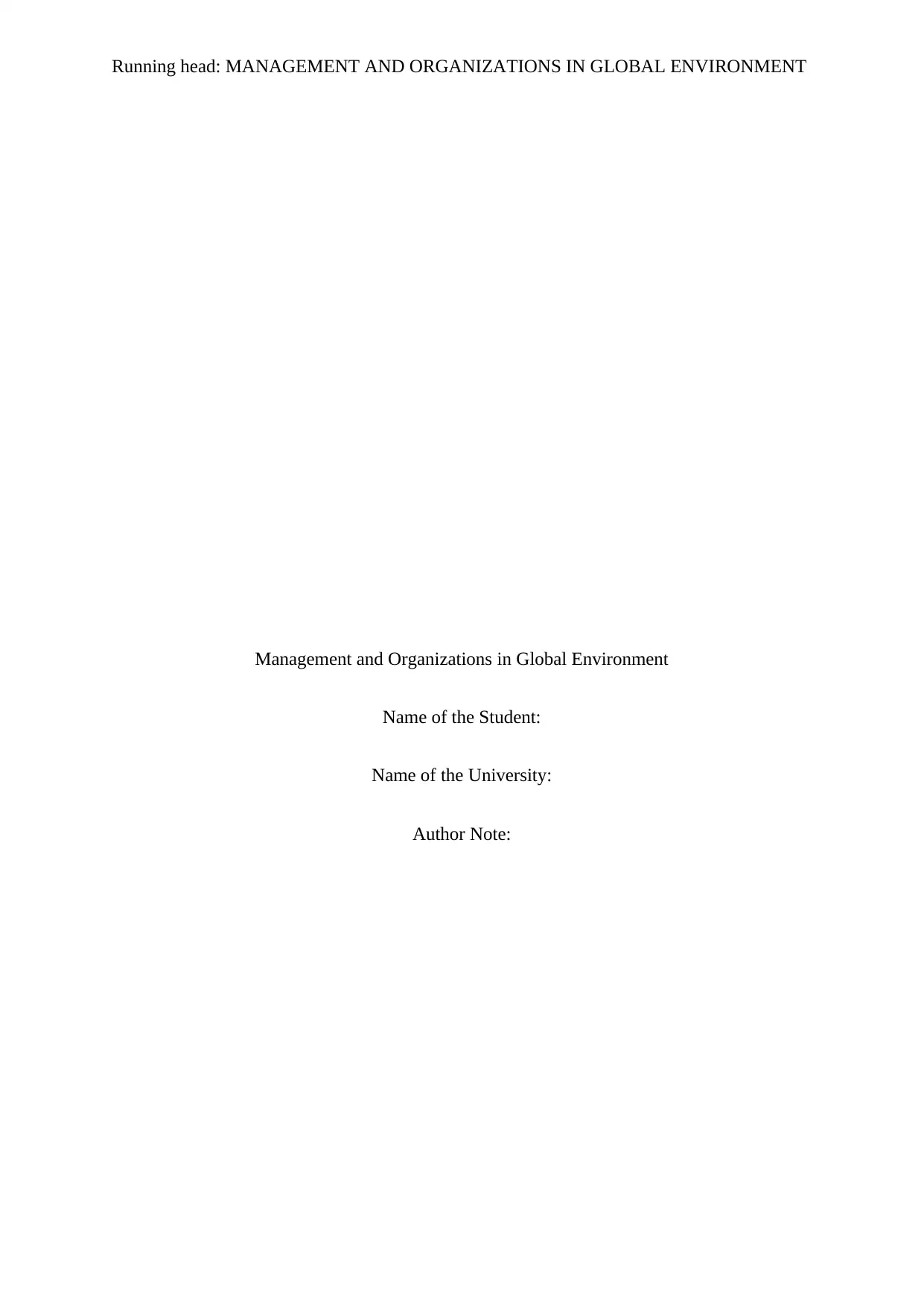
Running head: MANAGEMENT AND ORGANIZATIONS IN GLOBAL ENVIRONMENT
Management and Organizations in Global Environment
Name of the Student:
Name of the University:
Author Note:
Management and Organizations in Global Environment
Name of the Student:
Name of the University:
Author Note:
Paraphrase This Document
Need a fresh take? Get an instant paraphrase of this document with our AI Paraphraser
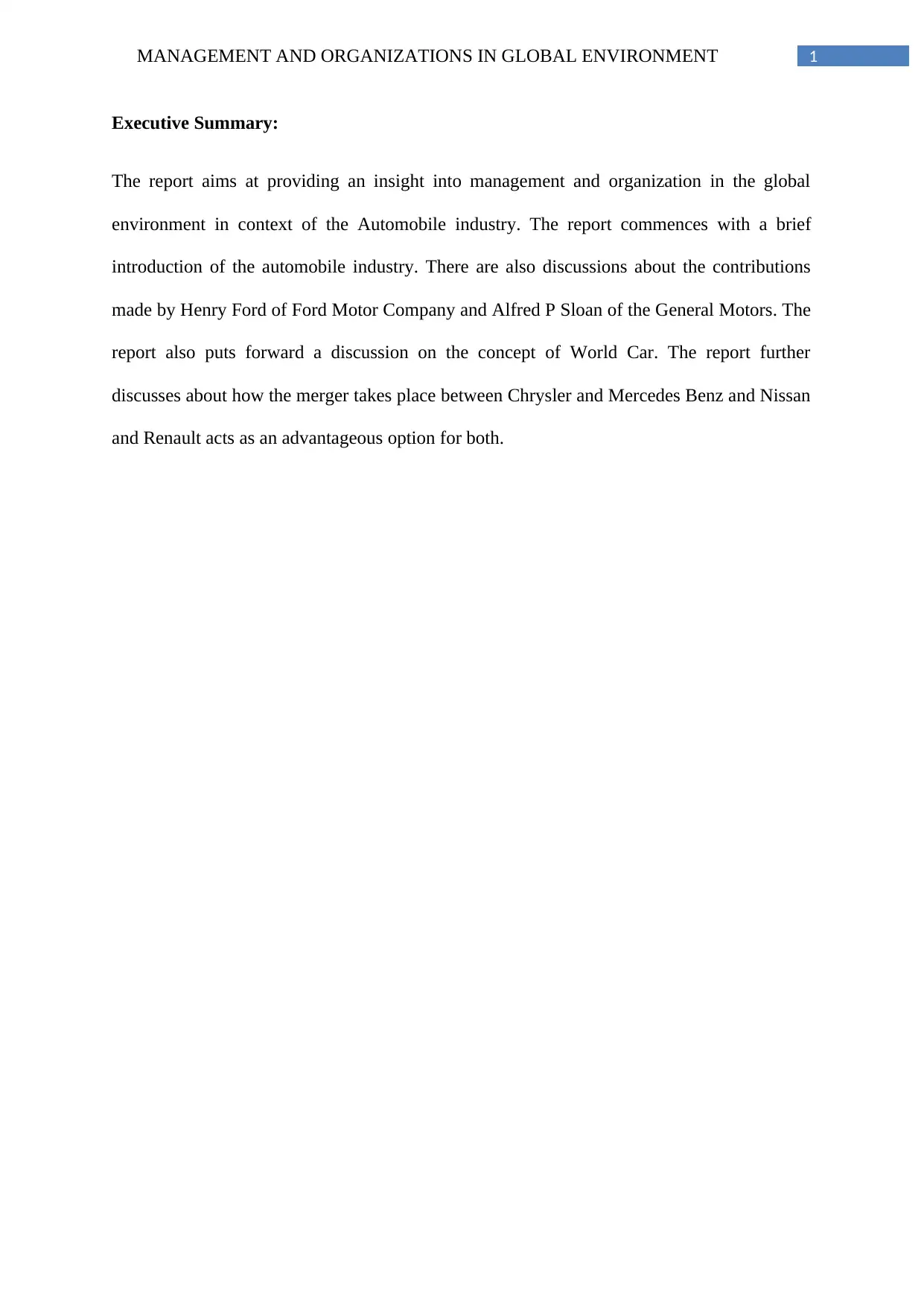
1MANAGEMENT AND ORGANIZATIONS IN GLOBAL ENVIRONMENT
Executive Summary:
The report aims at providing an insight into management and organization in the global
environment in context of the Automobile industry. The report commences with a brief
introduction of the automobile industry. There are also discussions about the contributions
made by Henry Ford of Ford Motor Company and Alfred P Sloan of the General Motors. The
report also puts forward a discussion on the concept of World Car. The report further
discusses about how the merger takes place between Chrysler and Mercedes Benz and Nissan
and Renault acts as an advantageous option for both.
Executive Summary:
The report aims at providing an insight into management and organization in the global
environment in context of the Automobile industry. The report commences with a brief
introduction of the automobile industry. There are also discussions about the contributions
made by Henry Ford of Ford Motor Company and Alfred P Sloan of the General Motors. The
report also puts forward a discussion on the concept of World Car. The report further
discusses about how the merger takes place between Chrysler and Mercedes Benz and Nissan
and Renault acts as an advantageous option for both.
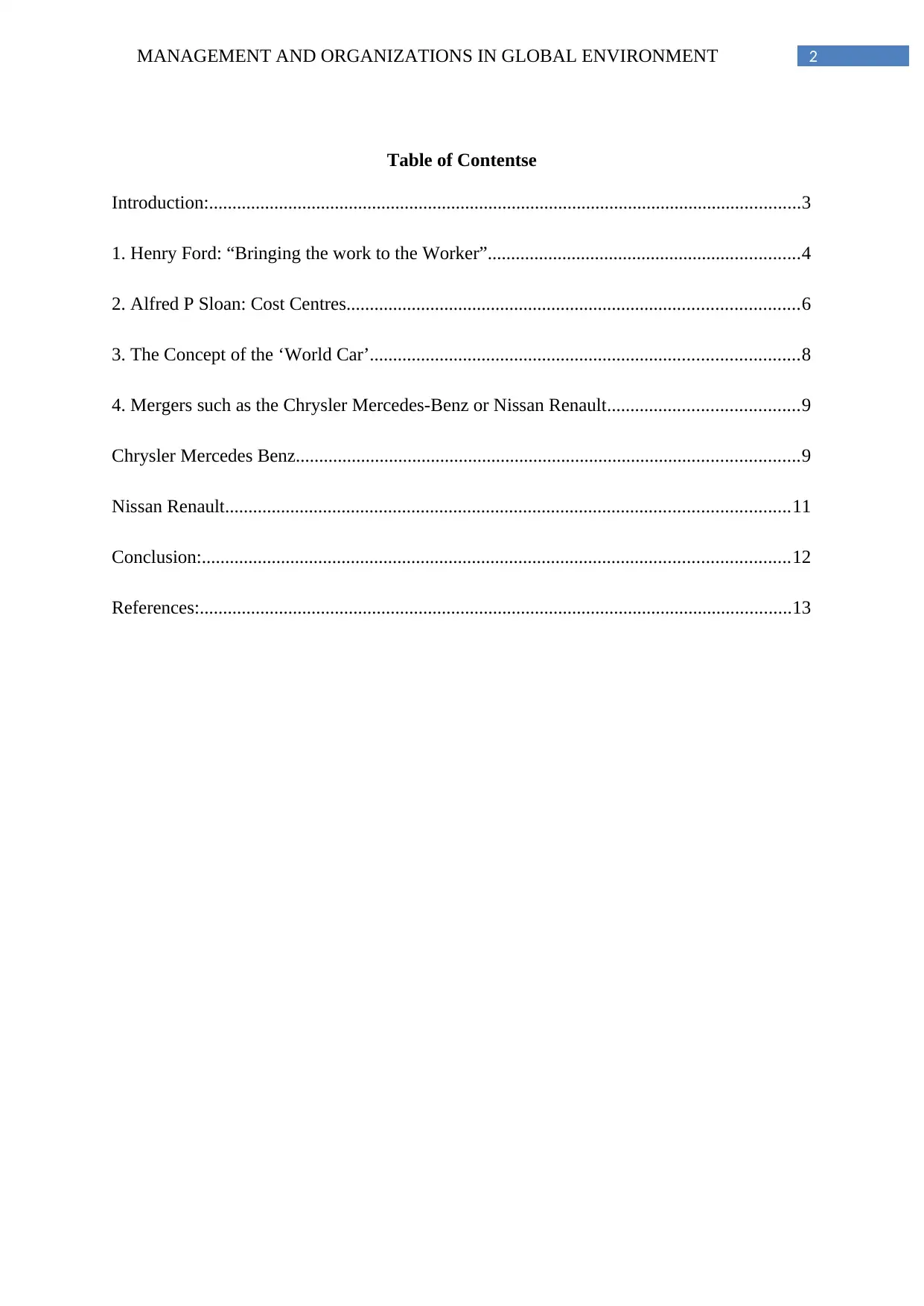
2MANAGEMENT AND ORGANIZATIONS IN GLOBAL ENVIRONMENT
Table of Contentse
Introduction:...............................................................................................................................3
1. Henry Ford: “Bringing the work to the Worker”...................................................................4
2. Alfred P Sloan: Cost Centres.................................................................................................6
3. The Concept of the ‘World Car’............................................................................................8
4. Mergers such as the Chrysler Mercedes-Benz or Nissan Renault.........................................9
Chrysler Mercedes Benz............................................................................................................9
Nissan Renault.........................................................................................................................11
Conclusion:..............................................................................................................................12
References:...............................................................................................................................13
Table of Contentse
Introduction:...............................................................................................................................3
1. Henry Ford: “Bringing the work to the Worker”...................................................................4
2. Alfred P Sloan: Cost Centres.................................................................................................6
3. The Concept of the ‘World Car’............................................................................................8
4. Mergers such as the Chrysler Mercedes-Benz or Nissan Renault.........................................9
Chrysler Mercedes Benz............................................................................................................9
Nissan Renault.........................................................................................................................11
Conclusion:..............................................................................................................................12
References:...............................................................................................................................13
⊘ This is a preview!⊘
Do you want full access?
Subscribe today to unlock all pages.

Trusted by 1+ million students worldwide
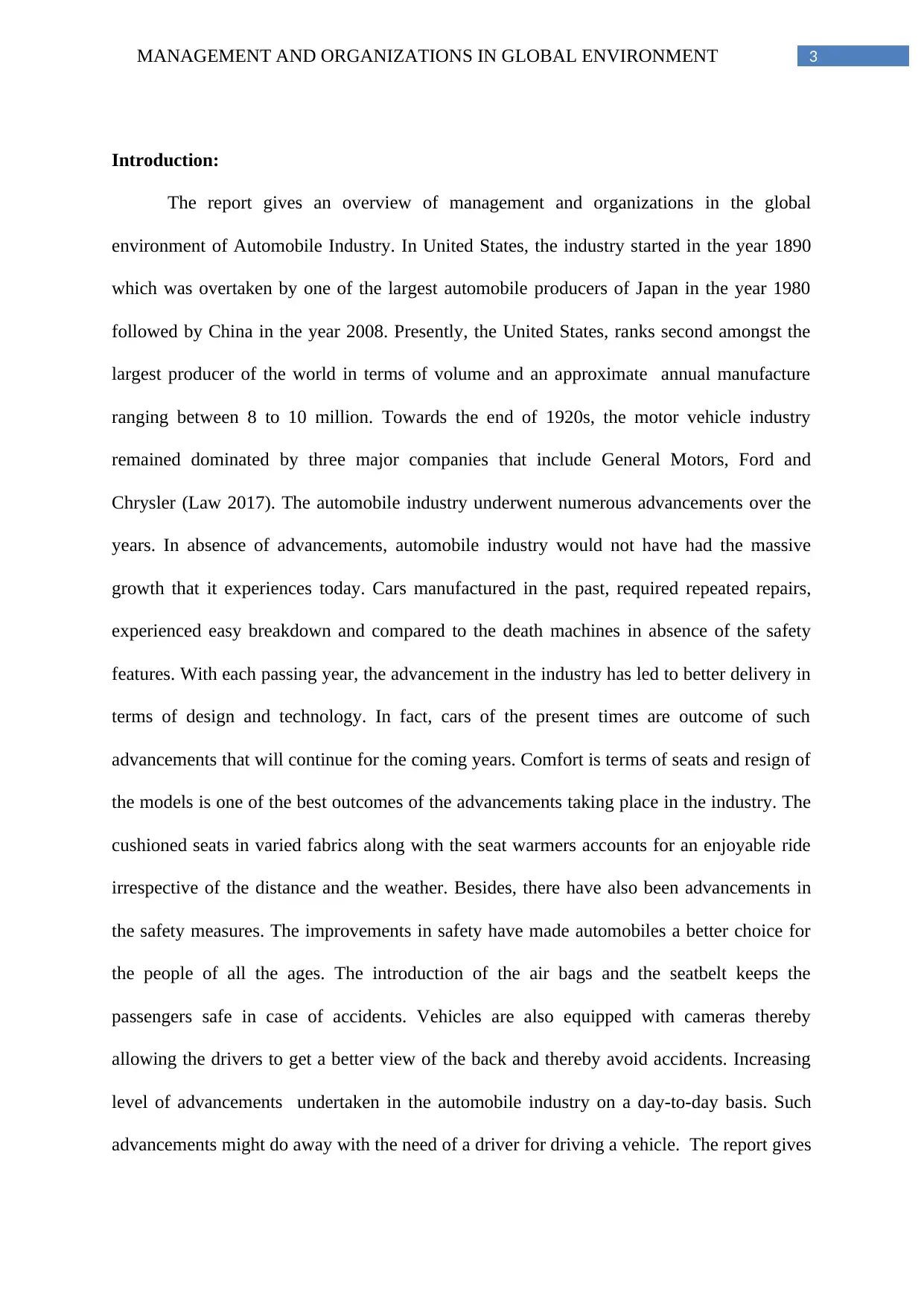
3MANAGEMENT AND ORGANIZATIONS IN GLOBAL ENVIRONMENT
Introduction:
The report gives an overview of management and organizations in the global
environment of Automobile Industry. In United States, the industry started in the year 1890
which was overtaken by one of the largest automobile producers of Japan in the year 1980
followed by China in the year 2008. Presently, the United States, ranks second amongst the
largest producer of the world in terms of volume and an approximate annual manufacture
ranging between 8 to 10 million. Towards the end of 1920s, the motor vehicle industry
remained dominated by three major companies that include General Motors, Ford and
Chrysler (Law 2017). The automobile industry underwent numerous advancements over the
years. In absence of advancements, automobile industry would not have had the massive
growth that it experiences today. Cars manufactured in the past, required repeated repairs,
experienced easy breakdown and compared to the death machines in absence of the safety
features. With each passing year, the advancement in the industry has led to better delivery in
terms of design and technology. In fact, cars of the present times are outcome of such
advancements that will continue for the coming years. Comfort is terms of seats and resign of
the models is one of the best outcomes of the advancements taking place in the industry. The
cushioned seats in varied fabrics along with the seat warmers accounts for an enjoyable ride
irrespective of the distance and the weather. Besides, there have also been advancements in
the safety measures. The improvements in safety have made automobiles a better choice for
the people of all the ages. The introduction of the air bags and the seatbelt keeps the
passengers safe in case of accidents. Vehicles are also equipped with cameras thereby
allowing the drivers to get a better view of the back and thereby avoid accidents. Increasing
level of advancements undertaken in the automobile industry on a day-to-day basis. Such
advancements might do away with the need of a driver for driving a vehicle. The report gives
Introduction:
The report gives an overview of management and organizations in the global
environment of Automobile Industry. In United States, the industry started in the year 1890
which was overtaken by one of the largest automobile producers of Japan in the year 1980
followed by China in the year 2008. Presently, the United States, ranks second amongst the
largest producer of the world in terms of volume and an approximate annual manufacture
ranging between 8 to 10 million. Towards the end of 1920s, the motor vehicle industry
remained dominated by three major companies that include General Motors, Ford and
Chrysler (Law 2017). The automobile industry underwent numerous advancements over the
years. In absence of advancements, automobile industry would not have had the massive
growth that it experiences today. Cars manufactured in the past, required repeated repairs,
experienced easy breakdown and compared to the death machines in absence of the safety
features. With each passing year, the advancement in the industry has led to better delivery in
terms of design and technology. In fact, cars of the present times are outcome of such
advancements that will continue for the coming years. Comfort is terms of seats and resign of
the models is one of the best outcomes of the advancements taking place in the industry. The
cushioned seats in varied fabrics along with the seat warmers accounts for an enjoyable ride
irrespective of the distance and the weather. Besides, there have also been advancements in
the safety measures. The improvements in safety have made automobiles a better choice for
the people of all the ages. The introduction of the air bags and the seatbelt keeps the
passengers safe in case of accidents. Vehicles are also equipped with cameras thereby
allowing the drivers to get a better view of the back and thereby avoid accidents. Increasing
level of advancements undertaken in the automobile industry on a day-to-day basis. Such
advancements might do away with the need of a driver for driving a vehicle. The report gives
Paraphrase This Document
Need a fresh take? Get an instant paraphrase of this document with our AI Paraphraser
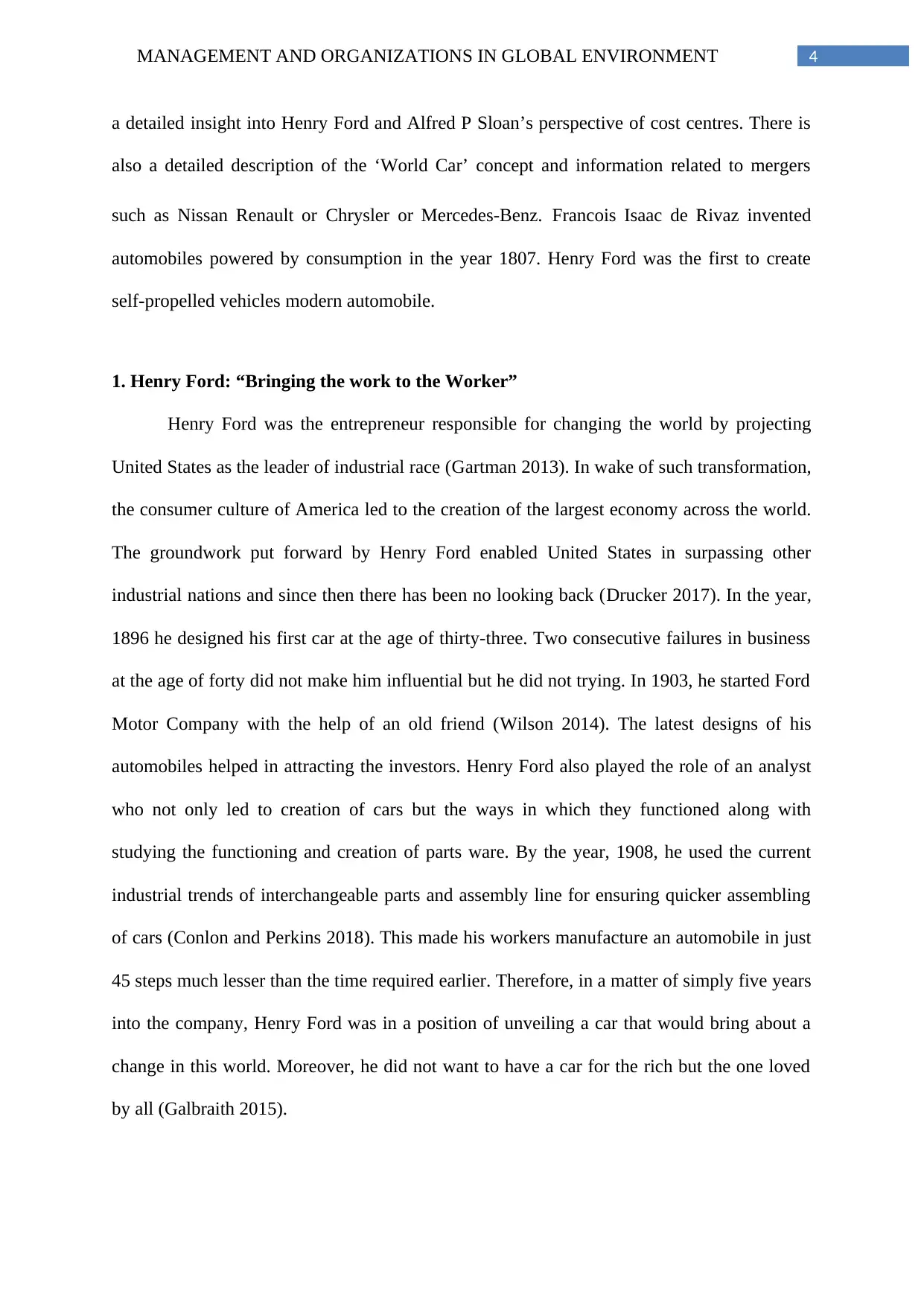
4MANAGEMENT AND ORGANIZATIONS IN GLOBAL ENVIRONMENT
a detailed insight into Henry Ford and Alfred P Sloan’s perspective of cost centres. There is
also a detailed description of the ‘World Car’ concept and information related to mergers
such as Nissan Renault or Chrysler or Mercedes-Benz. Francois Isaac de Rivaz invented
automobiles powered by consumption in the year 1807. Henry Ford was the first to create
self-propelled vehicles modern automobile.
1. Henry Ford: “Bringing the work to the Worker”
Henry Ford was the entrepreneur responsible for changing the world by projecting
United States as the leader of industrial race (Gartman 2013). In wake of such transformation,
the consumer culture of America led to the creation of the largest economy across the world.
The groundwork put forward by Henry Ford enabled United States in surpassing other
industrial nations and since then there has been no looking back (Drucker 2017). In the year,
1896 he designed his first car at the age of thirty-three. Two consecutive failures in business
at the age of forty did not make him influential but he did not trying. In 1903, he started Ford
Motor Company with the help of an old friend (Wilson 2014). The latest designs of his
automobiles helped in attracting the investors. Henry Ford also played the role of an analyst
who not only led to creation of cars but the ways in which they functioned along with
studying the functioning and creation of parts ware. By the year, 1908, he used the current
industrial trends of interchangeable parts and assembly line for ensuring quicker assembling
of cars (Conlon and Perkins 2018). This made his workers manufacture an automobile in just
45 steps much lesser than the time required earlier. Therefore, in a matter of simply five years
into the company, Henry Ford was in a position of unveiling a car that would bring about a
change in this world. Moreover, he did not want to have a car for the rich but the one loved
by all (Galbraith 2015).
a detailed insight into Henry Ford and Alfred P Sloan’s perspective of cost centres. There is
also a detailed description of the ‘World Car’ concept and information related to mergers
such as Nissan Renault or Chrysler or Mercedes-Benz. Francois Isaac de Rivaz invented
automobiles powered by consumption in the year 1807. Henry Ford was the first to create
self-propelled vehicles modern automobile.
1. Henry Ford: “Bringing the work to the Worker”
Henry Ford was the entrepreneur responsible for changing the world by projecting
United States as the leader of industrial race (Gartman 2013). In wake of such transformation,
the consumer culture of America led to the creation of the largest economy across the world.
The groundwork put forward by Henry Ford enabled United States in surpassing other
industrial nations and since then there has been no looking back (Drucker 2017). In the year,
1896 he designed his first car at the age of thirty-three. Two consecutive failures in business
at the age of forty did not make him influential but he did not trying. In 1903, he started Ford
Motor Company with the help of an old friend (Wilson 2014). The latest designs of his
automobiles helped in attracting the investors. Henry Ford also played the role of an analyst
who not only led to creation of cars but the ways in which they functioned along with
studying the functioning and creation of parts ware. By the year, 1908, he used the current
industrial trends of interchangeable parts and assembly line for ensuring quicker assembling
of cars (Conlon and Perkins 2018). This made his workers manufacture an automobile in just
45 steps much lesser than the time required earlier. Therefore, in a matter of simply five years
into the company, Henry Ford was in a position of unveiling a car that would bring about a
change in this world. Moreover, he did not want to have a car for the rich but the one loved
by all (Galbraith 2015).
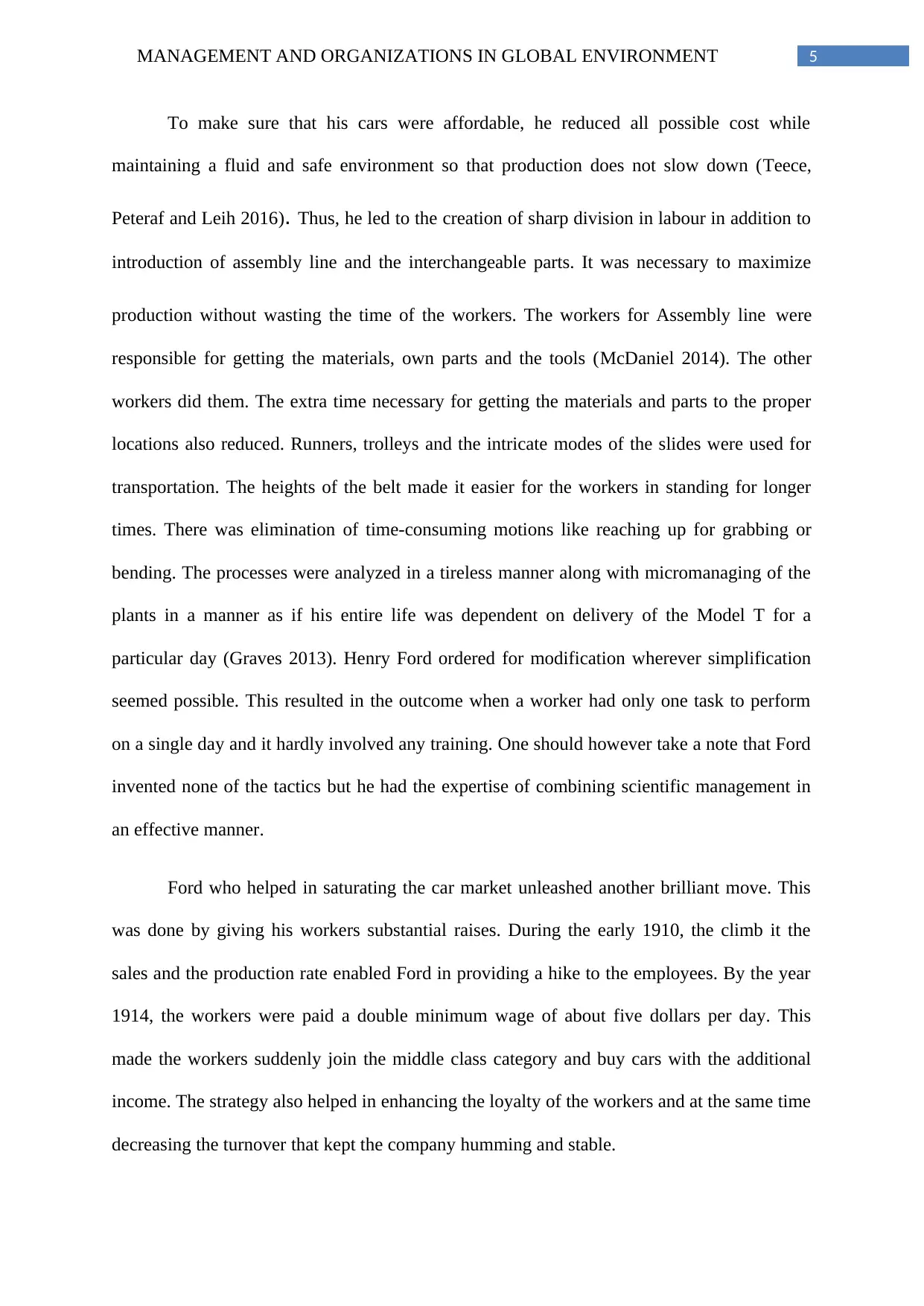
5MANAGEMENT AND ORGANIZATIONS IN GLOBAL ENVIRONMENT
To make sure that his cars were affordable, he reduced all possible cost while
maintaining a fluid and safe environment so that production does not slow down (Teece,
Peteraf and Leih 2016). Thus, he led to the creation of sharp division in labour in addition to
introduction of assembly line and the interchangeable parts. It was necessary to maximize
production without wasting the time of the workers. The workers for Assembly line were
responsible for getting the materials, own parts and the tools (McDaniel 2014). The other
workers did them. The extra time necessary for getting the materials and parts to the proper
locations also reduced. Runners, trolleys and the intricate modes of the slides were used for
transportation. The heights of the belt made it easier for the workers in standing for longer
times. There was elimination of time-consuming motions like reaching up for grabbing or
bending. The processes were analyzed in a tireless manner along with micromanaging of the
plants in a manner as if his entire life was dependent on delivery of the Model T for a
particular day (Graves 2013). Henry Ford ordered for modification wherever simplification
seemed possible. This resulted in the outcome when a worker had only one task to perform
on a single day and it hardly involved any training. One should however take a note that Ford
invented none of the tactics but he had the expertise of combining scientific management in
an effective manner.
Ford who helped in saturating the car market unleashed another brilliant move. This
was done by giving his workers substantial raises. During the early 1910, the climb it the
sales and the production rate enabled Ford in providing a hike to the employees. By the year
1914, the workers were paid a double minimum wage of about five dollars per day. This
made the workers suddenly join the middle class category and buy cars with the additional
income. The strategy also helped in enhancing the loyalty of the workers and at the same time
decreasing the turnover that kept the company humming and stable.
To make sure that his cars were affordable, he reduced all possible cost while
maintaining a fluid and safe environment so that production does not slow down (Teece,
Peteraf and Leih 2016). Thus, he led to the creation of sharp division in labour in addition to
introduction of assembly line and the interchangeable parts. It was necessary to maximize
production without wasting the time of the workers. The workers for Assembly line were
responsible for getting the materials, own parts and the tools (McDaniel 2014). The other
workers did them. The extra time necessary for getting the materials and parts to the proper
locations also reduced. Runners, trolleys and the intricate modes of the slides were used for
transportation. The heights of the belt made it easier for the workers in standing for longer
times. There was elimination of time-consuming motions like reaching up for grabbing or
bending. The processes were analyzed in a tireless manner along with micromanaging of the
plants in a manner as if his entire life was dependent on delivery of the Model T for a
particular day (Graves 2013). Henry Ford ordered for modification wherever simplification
seemed possible. This resulted in the outcome when a worker had only one task to perform
on a single day and it hardly involved any training. One should however take a note that Ford
invented none of the tactics but he had the expertise of combining scientific management in
an effective manner.
Ford who helped in saturating the car market unleashed another brilliant move. This
was done by giving his workers substantial raises. During the early 1910, the climb it the
sales and the production rate enabled Ford in providing a hike to the employees. By the year
1914, the workers were paid a double minimum wage of about five dollars per day. This
made the workers suddenly join the middle class category and buy cars with the additional
income. The strategy also helped in enhancing the loyalty of the workers and at the same time
decreasing the turnover that kept the company humming and stable.
⊘ This is a preview!⊘
Do you want full access?
Subscribe today to unlock all pages.

Trusted by 1+ million students worldwide
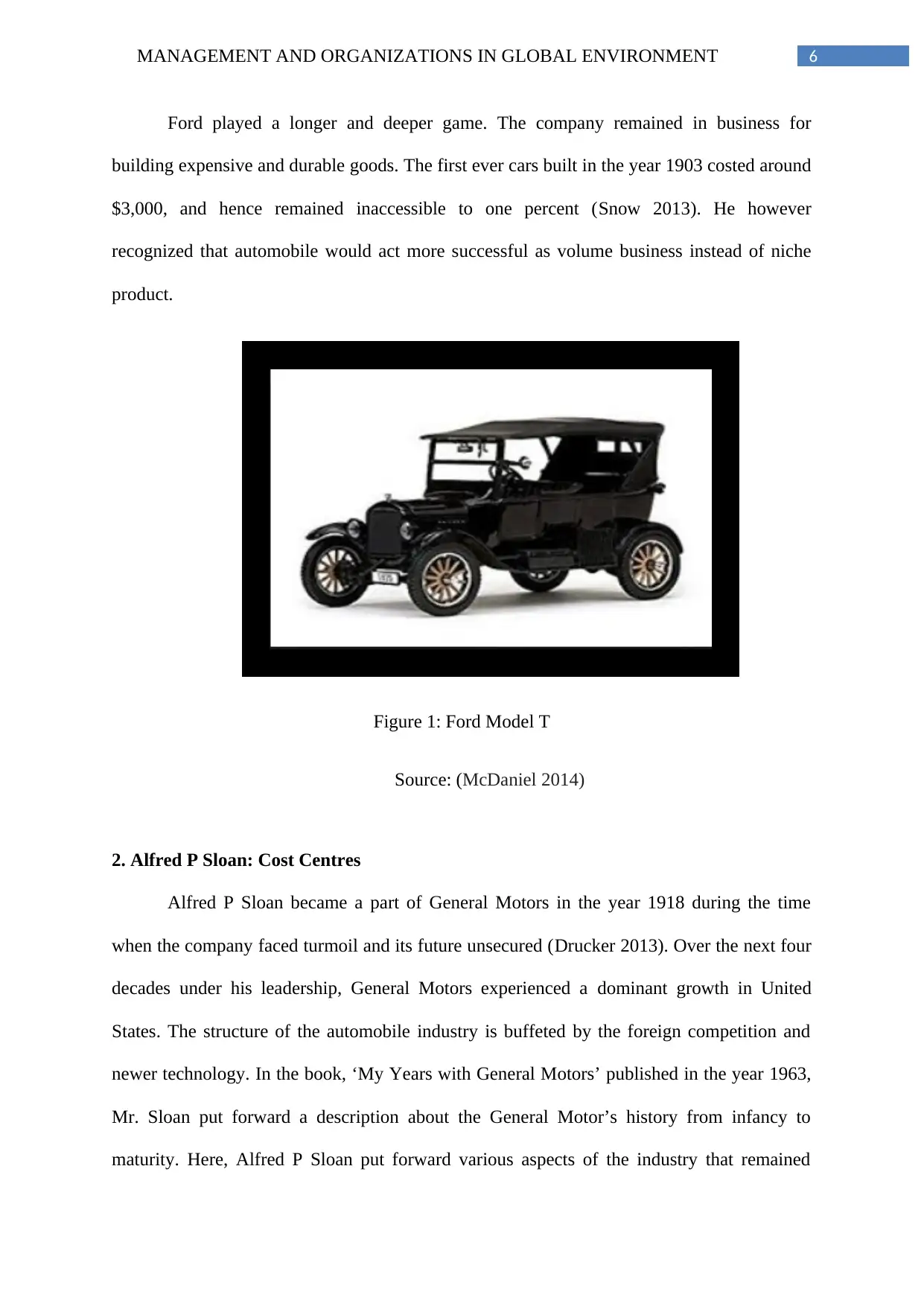
6MANAGEMENT AND ORGANIZATIONS IN GLOBAL ENVIRONMENT
Ford played a longer and deeper game. The company remained in business for
building expensive and durable goods. The first ever cars built in the year 1903 costed around
$3,000, and hence remained inaccessible to one percent (Snow 2013). He however
recognized that automobile would act more successful as volume business instead of niche
product.
Figure 1: Ford Model T
Source: (McDaniel 2014)
2. Alfred P Sloan: Cost Centres
Alfred P Sloan became a part of General Motors in the year 1918 during the time
when the company faced turmoil and its future unsecured (Drucker 2013). Over the next four
decades under his leadership, General Motors experienced a dominant growth in United
States. The structure of the automobile industry is buffeted by the foreign competition and
newer technology. In the book, ‘My Years with General Motors’ published in the year 1963,
Mr. Sloan put forward a description about the General Motor’s history from infancy to
maturity. Here, Alfred P Sloan put forward various aspects of the industry that remained
Ford played a longer and deeper game. The company remained in business for
building expensive and durable goods. The first ever cars built in the year 1903 costed around
$3,000, and hence remained inaccessible to one percent (Snow 2013). He however
recognized that automobile would act more successful as volume business instead of niche
product.
Figure 1: Ford Model T
Source: (McDaniel 2014)
2. Alfred P Sloan: Cost Centres
Alfred P Sloan became a part of General Motors in the year 1918 during the time
when the company faced turmoil and its future unsecured (Drucker 2013). Over the next four
decades under his leadership, General Motors experienced a dominant growth in United
States. The structure of the automobile industry is buffeted by the foreign competition and
newer technology. In the book, ‘My Years with General Motors’ published in the year 1963,
Mr. Sloan put forward a description about the General Motor’s history from infancy to
maturity. Here, Alfred P Sloan put forward various aspects of the industry that remained
Paraphrase This Document
Need a fresh take? Get an instant paraphrase of this document with our AI Paraphraser
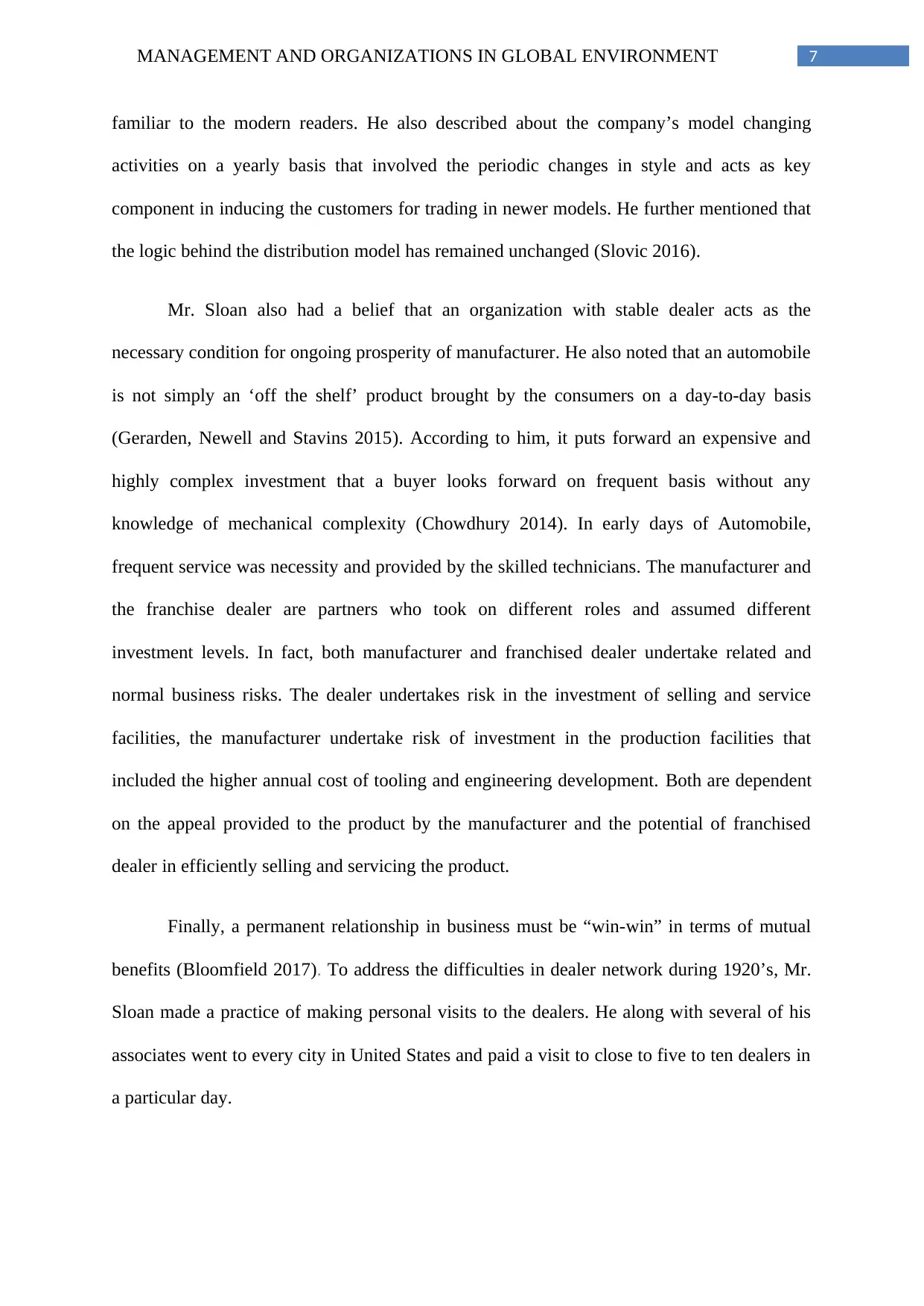
7MANAGEMENT AND ORGANIZATIONS IN GLOBAL ENVIRONMENT
familiar to the modern readers. He also described about the company’s model changing
activities on a yearly basis that involved the periodic changes in style and acts as key
component in inducing the customers for trading in newer models. He further mentioned that
the logic behind the distribution model has remained unchanged (Slovic 2016).
Mr. Sloan also had a belief that an organization with stable dealer acts as the
necessary condition for ongoing prosperity of manufacturer. He also noted that an automobile
is not simply an ‘off the shelf’ product brought by the consumers on a day-to-day basis
(Gerarden, Newell and Stavins 2015). According to him, it puts forward an expensive and
highly complex investment that a buyer looks forward on frequent basis without any
knowledge of mechanical complexity (Chowdhury 2014). In early days of Automobile,
frequent service was necessity and provided by the skilled technicians. The manufacturer and
the franchise dealer are partners who took on different roles and assumed different
investment levels. In fact, both manufacturer and franchised dealer undertake related and
normal business risks. The dealer undertakes risk in the investment of selling and service
facilities, the manufacturer undertake risk of investment in the production facilities that
included the higher annual cost of tooling and engineering development. Both are dependent
on the appeal provided to the product by the manufacturer and the potential of franchised
dealer in efficiently selling and servicing the product.
Finally, a permanent relationship in business must be “win-win” in terms of mutual
benefits (Bloomfield 2017). To address the difficulties in dealer network during 1920’s, Mr.
Sloan made a practice of making personal visits to the dealers. He along with several of his
associates went to every city in United States and paid a visit to close to five to ten dealers in
a particular day.
familiar to the modern readers. He also described about the company’s model changing
activities on a yearly basis that involved the periodic changes in style and acts as key
component in inducing the customers for trading in newer models. He further mentioned that
the logic behind the distribution model has remained unchanged (Slovic 2016).
Mr. Sloan also had a belief that an organization with stable dealer acts as the
necessary condition for ongoing prosperity of manufacturer. He also noted that an automobile
is not simply an ‘off the shelf’ product brought by the consumers on a day-to-day basis
(Gerarden, Newell and Stavins 2015). According to him, it puts forward an expensive and
highly complex investment that a buyer looks forward on frequent basis without any
knowledge of mechanical complexity (Chowdhury 2014). In early days of Automobile,
frequent service was necessity and provided by the skilled technicians. The manufacturer and
the franchise dealer are partners who took on different roles and assumed different
investment levels. In fact, both manufacturer and franchised dealer undertake related and
normal business risks. The dealer undertakes risk in the investment of selling and service
facilities, the manufacturer undertake risk of investment in the production facilities that
included the higher annual cost of tooling and engineering development. Both are dependent
on the appeal provided to the product by the manufacturer and the potential of franchised
dealer in efficiently selling and servicing the product.
Finally, a permanent relationship in business must be “win-win” in terms of mutual
benefits (Bloomfield 2017). To address the difficulties in dealer network during 1920’s, Mr.
Sloan made a practice of making personal visits to the dealers. He along with several of his
associates went to every city in United States and paid a visit to close to five to ten dealers in
a particular day.
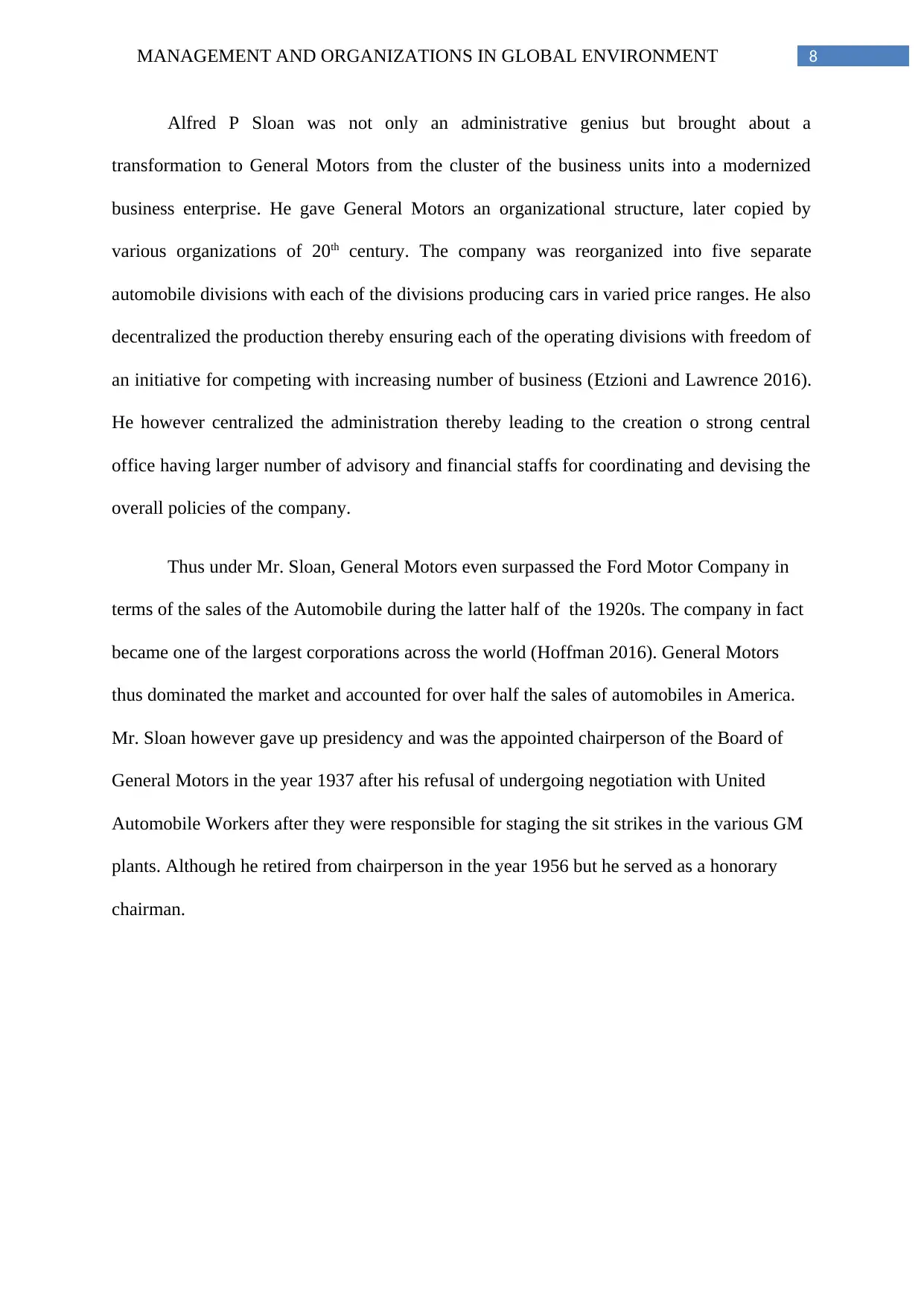
8MANAGEMENT AND ORGANIZATIONS IN GLOBAL ENVIRONMENT
Alfred P Sloan was not only an administrative genius but brought about a
transformation to General Motors from the cluster of the business units into a modernized
business enterprise. He gave General Motors an organizational structure, later copied by
various organizations of 20th century. The company was reorganized into five separate
automobile divisions with each of the divisions producing cars in varied price ranges. He also
decentralized the production thereby ensuring each of the operating divisions with freedom of
an initiative for competing with increasing number of business (Etzioni and Lawrence 2016).
He however centralized the administration thereby leading to the creation o strong central
office having larger number of advisory and financial staffs for coordinating and devising the
overall policies of the company.
Thus under Mr. Sloan, General Motors even surpassed the Ford Motor Company in
terms of the sales of the Automobile during the latter half of the 1920s. The company in fact
became one of the largest corporations across the world (Hoffman 2016). General Motors
thus dominated the market and accounted for over half the sales of automobiles in America.
Mr. Sloan however gave up presidency and was the appointed chairperson of the Board of
General Motors in the year 1937 after his refusal of undergoing negotiation with United
Automobile Workers after they were responsible for staging the sit strikes in the various GM
plants. Although he retired from chairperson in the year 1956 but he served as a honorary
chairman.
Alfred P Sloan was not only an administrative genius but brought about a
transformation to General Motors from the cluster of the business units into a modernized
business enterprise. He gave General Motors an organizational structure, later copied by
various organizations of 20th century. The company was reorganized into five separate
automobile divisions with each of the divisions producing cars in varied price ranges. He also
decentralized the production thereby ensuring each of the operating divisions with freedom of
an initiative for competing with increasing number of business (Etzioni and Lawrence 2016).
He however centralized the administration thereby leading to the creation o strong central
office having larger number of advisory and financial staffs for coordinating and devising the
overall policies of the company.
Thus under Mr. Sloan, General Motors even surpassed the Ford Motor Company in
terms of the sales of the Automobile during the latter half of the 1920s. The company in fact
became one of the largest corporations across the world (Hoffman 2016). General Motors
thus dominated the market and accounted for over half the sales of automobiles in America.
Mr. Sloan however gave up presidency and was the appointed chairperson of the Board of
General Motors in the year 1937 after his refusal of undergoing negotiation with United
Automobile Workers after they were responsible for staging the sit strikes in the various GM
plants. Although he retired from chairperson in the year 1956 but he served as a honorary
chairman.
⊘ This is a preview!⊘
Do you want full access?
Subscribe today to unlock all pages.

Trusted by 1+ million students worldwide
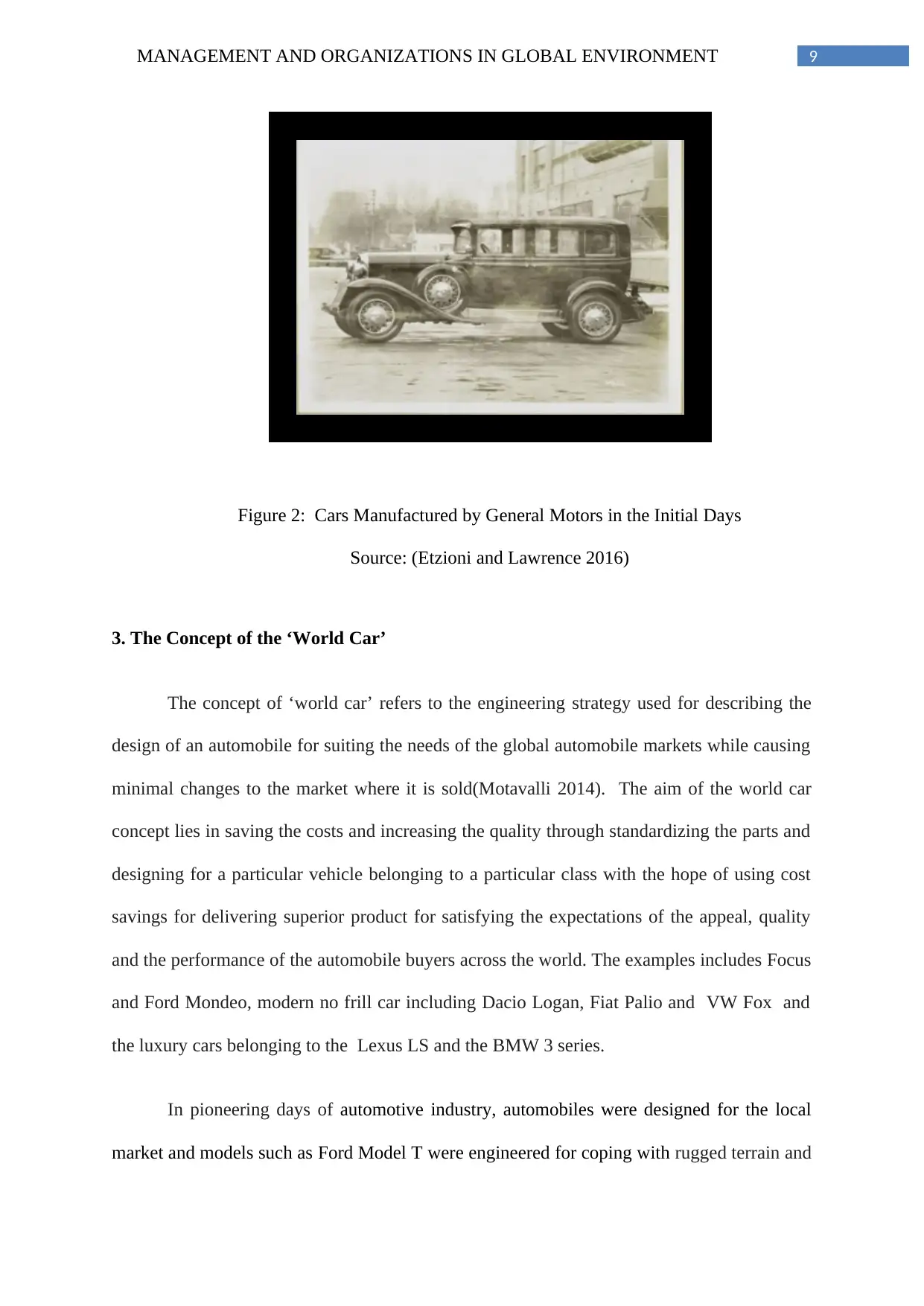
9MANAGEMENT AND ORGANIZATIONS IN GLOBAL ENVIRONMENT
Figure 2: Cars Manufactured by General Motors in the Initial Days
Source: (Etzioni and Lawrence 2016)
3. The Concept of the ‘World Car’
The concept of ‘world car’ refers to the engineering strategy used for describing the
design of an automobile for suiting the needs of the global automobile markets while causing
minimal changes to the market where it is sold(Motavalli 2014). The aim of the world car
concept lies in saving the costs and increasing the quality through standardizing the parts and
designing for a particular vehicle belonging to a particular class with the hope of using cost
savings for delivering superior product for satisfying the expectations of the appeal, quality
and the performance of the automobile buyers across the world. The examples includes Focus
and Ford Mondeo, modern no frill car including Dacio Logan, Fiat Palio and VW Fox and
the luxury cars belonging to the Lexus LS and the BMW 3 series.
In pioneering days of automotive industry, automobiles were designed for the local
market and models such as Ford Model T were engineered for coping with rugged terrain and
Figure 2: Cars Manufactured by General Motors in the Initial Days
Source: (Etzioni and Lawrence 2016)
3. The Concept of the ‘World Car’
The concept of ‘world car’ refers to the engineering strategy used for describing the
design of an automobile for suiting the needs of the global automobile markets while causing
minimal changes to the market where it is sold(Motavalli 2014). The aim of the world car
concept lies in saving the costs and increasing the quality through standardizing the parts and
designing for a particular vehicle belonging to a particular class with the hope of using cost
savings for delivering superior product for satisfying the expectations of the appeal, quality
and the performance of the automobile buyers across the world. The examples includes Focus
and Ford Mondeo, modern no frill car including Dacio Logan, Fiat Palio and VW Fox and
the luxury cars belonging to the Lexus LS and the BMW 3 series.
In pioneering days of automotive industry, automobiles were designed for the local
market and models such as Ford Model T were engineered for coping with rugged terrain and
Paraphrase This Document
Need a fresh take? Get an instant paraphrase of this document with our AI Paraphraser
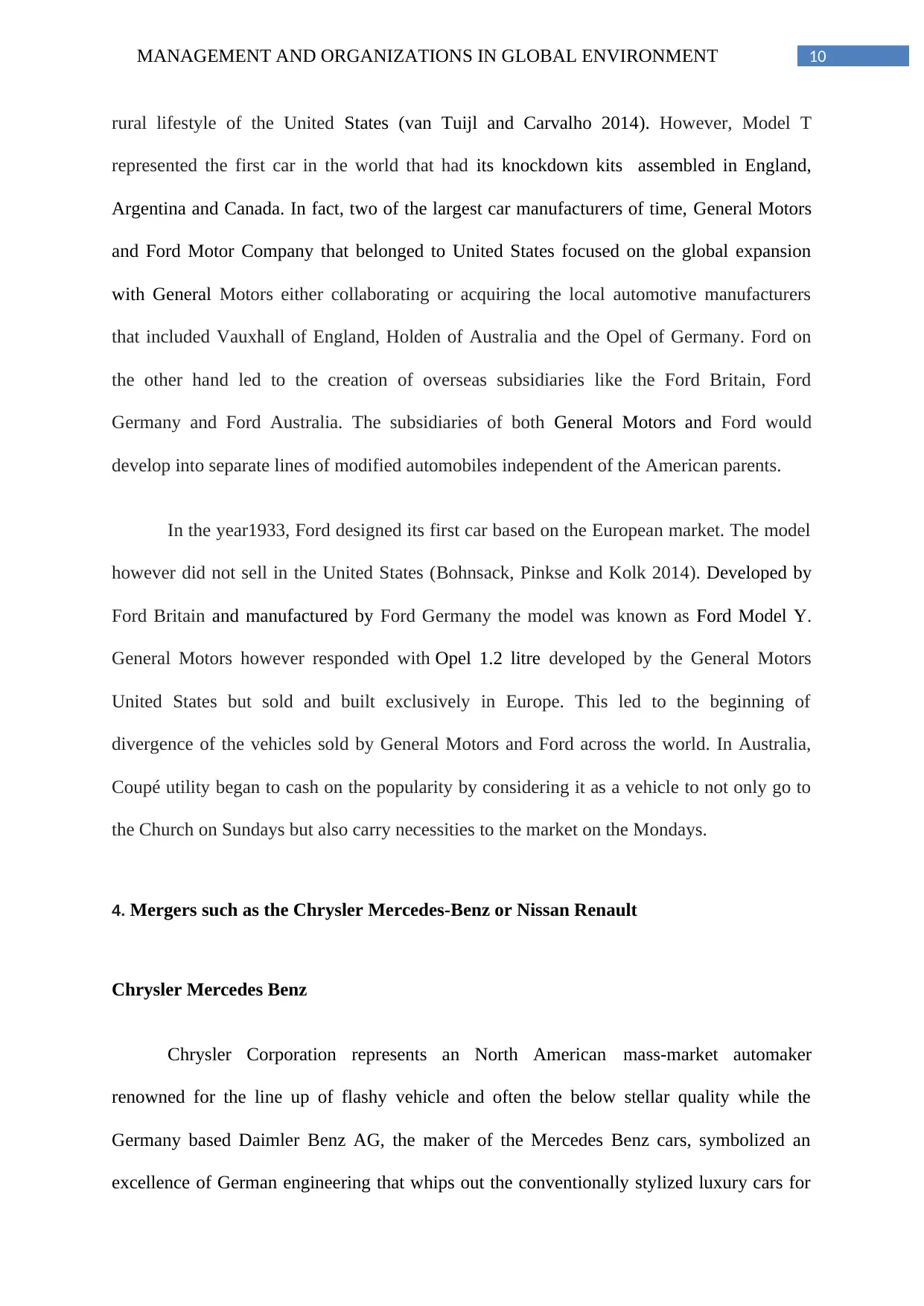
10MANAGEMENT AND ORGANIZATIONS IN GLOBAL ENVIRONMENT
rural lifestyle of the United States (van Tuijl and Carvalho 2014). However, Model T
represented the first car in the world that had its knockdown kits assembled in England,
Argentina and Canada. In fact, two of the largest car manufacturers of time, General Motors
and Ford Motor Company that belonged to United States focused on the global expansion
with General Motors either collaborating or acquiring the local automotive manufacturers
that included Vauxhall of England, Holden of Australia and the Opel of Germany. Ford on
the other hand led to the creation of overseas subsidiaries like the Ford Britain, Ford
Germany and Ford Australia. The subsidiaries of both General Motors and Ford would
develop into separate lines of modified automobiles independent of the American parents.
In the year1933, Ford designed its first car based on the European market. The model
however did not sell in the United States (Bohnsack, Pinkse and Kolk 2014). Developed by
Ford Britain and manufactured by Ford Germany the model was known as Ford Model Y.
General Motors however responded with Opel 1.2 litre developed by the General Motors
United States but sold and built exclusively in Europe. This led to the beginning of
divergence of the vehicles sold by General Motors and Ford across the world. In Australia,
Coupé utility began to cash on the popularity by considering it as a vehicle to not only go to
the Church on Sundays but also carry necessities to the market on the Mondays.
4. Mergers such as the Chrysler Mercedes-Benz or Nissan Renault
Chrysler Mercedes Benz
Chrysler Corporation represents an North American mass-market automaker
renowned for the line up of flashy vehicle and often the below stellar quality while the
Germany based Daimler Benz AG, the maker of the Mercedes Benz cars, symbolized an
excellence of German engineering that whips out the conventionally stylized luxury cars for
rural lifestyle of the United States (van Tuijl and Carvalho 2014). However, Model T
represented the first car in the world that had its knockdown kits assembled in England,
Argentina and Canada. In fact, two of the largest car manufacturers of time, General Motors
and Ford Motor Company that belonged to United States focused on the global expansion
with General Motors either collaborating or acquiring the local automotive manufacturers
that included Vauxhall of England, Holden of Australia and the Opel of Germany. Ford on
the other hand led to the creation of overseas subsidiaries like the Ford Britain, Ford
Germany and Ford Australia. The subsidiaries of both General Motors and Ford would
develop into separate lines of modified automobiles independent of the American parents.
In the year1933, Ford designed its first car based on the European market. The model
however did not sell in the United States (Bohnsack, Pinkse and Kolk 2014). Developed by
Ford Britain and manufactured by Ford Germany the model was known as Ford Model Y.
General Motors however responded with Opel 1.2 litre developed by the General Motors
United States but sold and built exclusively in Europe. This led to the beginning of
divergence of the vehicles sold by General Motors and Ford across the world. In Australia,
Coupé utility began to cash on the popularity by considering it as a vehicle to not only go to
the Church on Sundays but also carry necessities to the market on the Mondays.
4. Mergers such as the Chrysler Mercedes-Benz or Nissan Renault
Chrysler Mercedes Benz
Chrysler Corporation represents an North American mass-market automaker
renowned for the line up of flashy vehicle and often the below stellar quality while the
Germany based Daimler Benz AG, the maker of the Mercedes Benz cars, symbolized an
excellence of German engineering that whips out the conventionally stylized luxury cars for
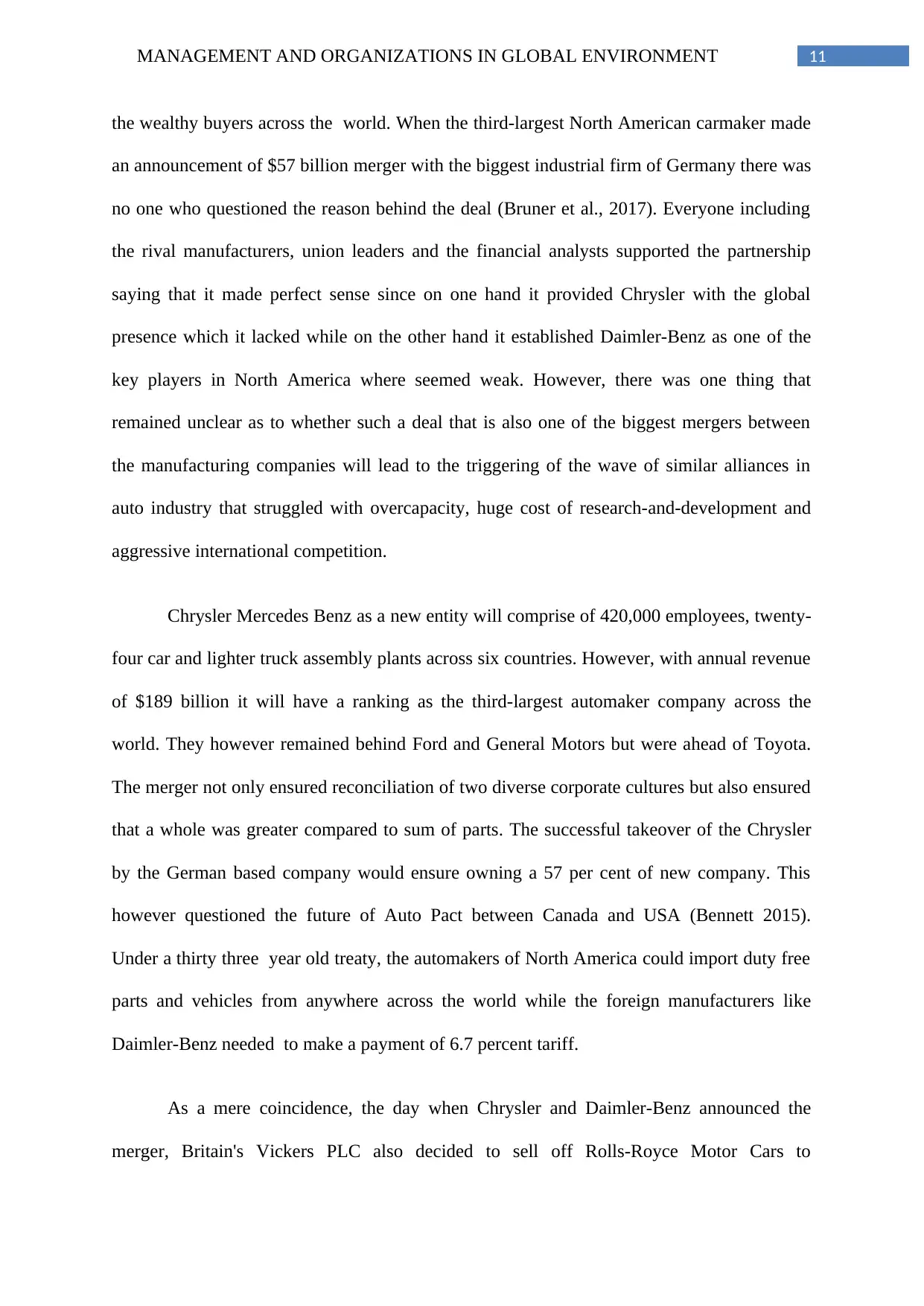
11MANAGEMENT AND ORGANIZATIONS IN GLOBAL ENVIRONMENT
the wealthy buyers across the world. When the third-largest North American carmaker made
an announcement of $57 billion merger with the biggest industrial firm of Germany there was
no one who questioned the reason behind the deal (Bruner et al., 2017). Everyone including
the rival manufacturers, union leaders and the financial analysts supported the partnership
saying that it made perfect sense since on one hand it provided Chrysler with the global
presence which it lacked while on the other hand it established Daimler-Benz as one of the
key players in North America where seemed weak. However, there was one thing that
remained unclear as to whether such a deal that is also one of the biggest mergers between
the manufacturing companies will lead to the triggering of the wave of similar alliances in
auto industry that struggled with overcapacity, huge cost of research-and-development and
aggressive international competition.
Chrysler Mercedes Benz as a new entity will comprise of 420,000 employees, twenty-
four car and lighter truck assembly plants across six countries. However, with annual revenue
of $189 billion it will have a ranking as the third-largest automaker company across the
world. They however remained behind Ford and General Motors but were ahead of Toyota.
The merger not only ensured reconciliation of two diverse corporate cultures but also ensured
that a whole was greater compared to sum of parts. The successful takeover of the Chrysler
by the German based company would ensure owning a 57 per cent of new company. This
however questioned the future of Auto Pact between Canada and USA (Bennett 2015).
Under a thirty three year old treaty, the automakers of North America could import duty free
parts and vehicles from anywhere across the world while the foreign manufacturers like
Daimler-Benz needed to make a payment of 6.7 percent tariff.
As a mere coincidence, the day when Chrysler and Daimler-Benz announced the
merger, Britain's Vickers PLC also decided to sell off Rolls-Royce Motor Cars to
the wealthy buyers across the world. When the third-largest North American carmaker made
an announcement of $57 billion merger with the biggest industrial firm of Germany there was
no one who questioned the reason behind the deal (Bruner et al., 2017). Everyone including
the rival manufacturers, union leaders and the financial analysts supported the partnership
saying that it made perfect sense since on one hand it provided Chrysler with the global
presence which it lacked while on the other hand it established Daimler-Benz as one of the
key players in North America where seemed weak. However, there was one thing that
remained unclear as to whether such a deal that is also one of the biggest mergers between
the manufacturing companies will lead to the triggering of the wave of similar alliances in
auto industry that struggled with overcapacity, huge cost of research-and-development and
aggressive international competition.
Chrysler Mercedes Benz as a new entity will comprise of 420,000 employees, twenty-
four car and lighter truck assembly plants across six countries. However, with annual revenue
of $189 billion it will have a ranking as the third-largest automaker company across the
world. They however remained behind Ford and General Motors but were ahead of Toyota.
The merger not only ensured reconciliation of two diverse corporate cultures but also ensured
that a whole was greater compared to sum of parts. The successful takeover of the Chrysler
by the German based company would ensure owning a 57 per cent of new company. This
however questioned the future of Auto Pact between Canada and USA (Bennett 2015).
Under a thirty three year old treaty, the automakers of North America could import duty free
parts and vehicles from anywhere across the world while the foreign manufacturers like
Daimler-Benz needed to make a payment of 6.7 percent tariff.
As a mere coincidence, the day when Chrysler and Daimler-Benz announced the
merger, Britain's Vickers PLC also decided to sell off Rolls-Royce Motor Cars to
⊘ This is a preview!⊘
Do you want full access?
Subscribe today to unlock all pages.

Trusted by 1+ million students worldwide
1 out of 19
Related Documents
Your All-in-One AI-Powered Toolkit for Academic Success.
+13062052269
info@desklib.com
Available 24*7 on WhatsApp / Email
![[object Object]](/_next/static/media/star-bottom.7253800d.svg)
Unlock your academic potential
Copyright © 2020–2025 A2Z Services. All Rights Reserved. Developed and managed by ZUCOL.




